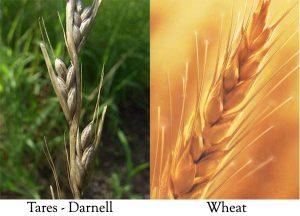Fruits of Spiritual Harvest-Wheat
When the Israelites were entering the Promised Land, God told them it would be filled with seven distinct fruits as signs of His Abundance and Presence in the country. The first of these named fruits was wheat, which not only proved to be an essential source of food for its ability to be stored long-term, but was a symbol of those whose fruits would be everlasting.
Wheat was first mentioned in Genesis 30:14, when Patriarch Jacob and his growing family were participating in the wheat harvest, which was one of the most economically important to Israel. The wheat harvest was also the framework for the Feast of Weeks, known today as Pentecost, when the early Church first received the Holy Spirit.
Jesus referenced the wheat harvest in the parable of the tares, describing the Kingdom of Heaven as a field planted with good seeds, which had been corrupted by weeds sown by the enemy. Though the servants advocated removing the weeds, the master explained that doing so would root up the good wheat as well. Instead, the master suggested that they wait till harvest time, then the reapers would be able to distinguish between the weeds and wheat, based on their fruiting bodies, and then separate them to be burned or put into the master’s storehouse (ref. Matthew 12:24-30).

Lolium temulentum, typically known as darnel, poison darnel, darnel ryegrass or cockle is suspected of being the weeds referred to in this parable. This is due to the fact that up until the plant matures and begins to produce fruit, it is difficult to distinguish between wheat. More heinously, this weed’s name “temelentus” means “drunk” in Latin to describe the drunken nausea commonly associated with eating the grain, after it has been infected by a common fungus, which can lead to death if consumed.
Jesus wanted to stress that there would be many followers that had the appearance of being Christians, but it was by their “fruits“ that each would be differentiated. There was also a stark contrast between how each would ultimately be dealt with, the toxic tares and the life-giving grain would be harvested and protected in the barn.
Jesus also uses the wheat cultivation as a way to explain the process of producing fruit, saying that “unless a kernel of wheat fall into the ground and die, it abideth alone: but if it die, it bringeth forth much fruit“. Christ further clarifies that if a man loves his life, he will lose it; but those who forgo this world to serve and follow Christ, will experience eternal life, beside Christ, and will be honored by the Father (ref. John 12:24-26).
This was a difficult concept to accept for people who expected Christ to bring a physical kingdom. They anticipated that He would be ruling and reigning from an earthly throne, but He was very direct about the fact that His Body and their physical expectations must die away in order to produce spiritual fruits.
Wheat was an essential foodstuff for the ancient world and Christ used its husbandry to explain how His Followers would be distinct, based on their fruits, compared to those who simply claimed His Name. Wheat was further used to explain that we must forgo material things to produce spiritual crops. The wheat harvest was also the moment when the Holy Spirit first filled the early Church.
God promised Israel a land blessed with a generous wheat harvest. He promised His Church would be blessed with the Holy Spirit, that, if they followed and worshiped Him, they would produce spiritual fruits, and that they would be a part of the elect who would be separated from the rest of the world to be taken to Heaven. As Pentecost approaches, we pray that you are filled with the Holy Spirit, and producing spiritual fruits in anticipation for eternity, in His Spiritual Kingdom.
Prepared by, Kent Simpson, Apostolic Prophet & Eric Sepulveda, PMT Administrator
For more prophetic media groups click here



